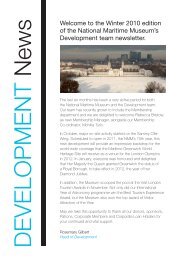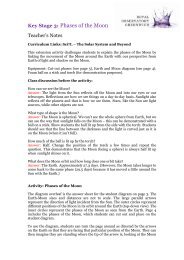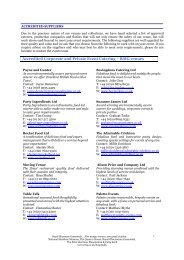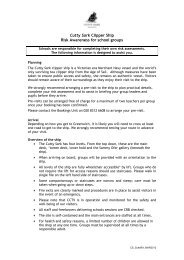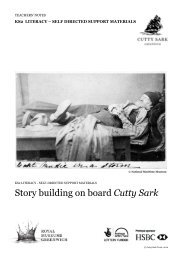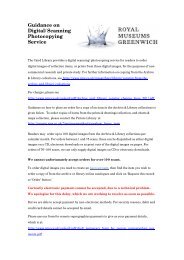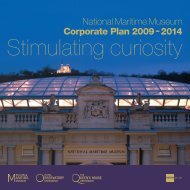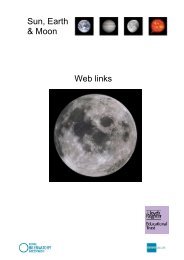The Volunteer - National Maritime Museum
The Volunteer - National Maritime Museum
The Volunteer - National Maritime Museum
You also want an ePaper? Increase the reach of your titles
YUMPU automatically turns print PDFs into web optimized ePapers that Google loves.
<strong>The</strong> Voyage of the<br />
Ping Wo<br />
<strong>The</strong> Ping Wo (‘Equitable Harmony’ in<br />
Mandarin) was a flat bottomed river steamer<br />
of 3105 tons, built in China in 1922, which<br />
had operated on the Yangtze River between<br />
Chongqing and Shanghai before she found<br />
her way to Singapore.<br />
How and why she arrived there in 1941, I<br />
have been unable to discover. She was<br />
requisitioned in December 1941 by the Royal<br />
Navy and used to tow the destroyer HMAS<br />
Vendetta, which was refitting there, to<br />
Australia at 3 knots. She was then<br />
commissioned by the Royal Australian Navy<br />
in May 1942 and operated throughout the<br />
Pacific War in a variety of roles.<br />
In 1946 the RAN planned her return to the<br />
pre-war owners and it was in April that year<br />
that I had my first sight of her in Sydney<br />
Harbour. I was one of a Royal Navy party<br />
drafted to take passage in her to Hong Kong,<br />
and as we boarded her the C.P.O. of the<br />
regular RAN crew opined that it was very<br />
unlikely we would complete the voyage. Given<br />
that she had been described as a ‘clapped out<br />
rust bucket’ by her first C.O. it was easy to<br />
understand his pessimism, and mine! Our<br />
sailing was delayed for 11 days till a cyclone<br />
passed and we finally left on 20 April. It<br />
would take much more space than I have here<br />
to detail all the incidents encountered on the<br />
voyage, but this brief narrative includes some<br />
of them.<br />
A severe leakage in our water tank developed<br />
immediately and we put into Brisbane for<br />
repairs. We then sailed, first to Townsville<br />
and then on to Thursday Island off the tip of<br />
NE Australia. We had to anchor every night<br />
as the bridge compass developed a fault,<br />
and there were obvious navigational<br />
problems proceeding through the dangerous<br />
Barrier Reef.<br />
After an interesting stay at Thursday Island,<br />
where I met some pearl divers, one of whom<br />
had lost a leg to a shark, we wallowed across<br />
the Gulf of Carpentaria to Darwin in a heavy<br />
swell. <strong>The</strong> noise of the sea smashing up<br />
against the sponsons was an unpleasant<br />
accompaniment to our progress,<br />
compounded by water flooding into the after<br />
-hold through a cargo door on the waterline.<br />
To our relief a shipwright on board was able<br />
to cement the door, but soon after this our<br />
steering gear broke down and we had to<br />
drop anchor for the night 50 miles from<br />
Darwin while repairs were effected. Darwin<br />
itself at that time was a small town, still with<br />
heavy bomb damage left over from Japanese<br />
air raids in 1942.<br />
Our progress from there across the Timor<br />
Sea was interrupted when a rating on board<br />
developed acute appendicitis and we had to<br />
turn back, racing for 7 hours at 12 knots to<br />
meet the cruiser HMS Euryalus, which had<br />
fortunately just left Darwin for Sydney and<br />
which sped north at her maximum speed. As<br />
our normal designed speed was a rarely<br />
obtained 10 knots it felt as though Ping Wo<br />
would be shaken to pieces in this dash<br />
which, however, had a happy outcome with<br />
the rating having a successful operation after<br />
being transferred to Euryalus.<br />
Our passage through the Flores Sea was very<br />
scenic, with a long string of volcanic islands<br />
visible, some rising to 5000 feet. Many shore<br />
navigational lights in these waters were still<br />
missing at this time and as a result one night<br />
we nearly ran aground on an island.<br />
5




